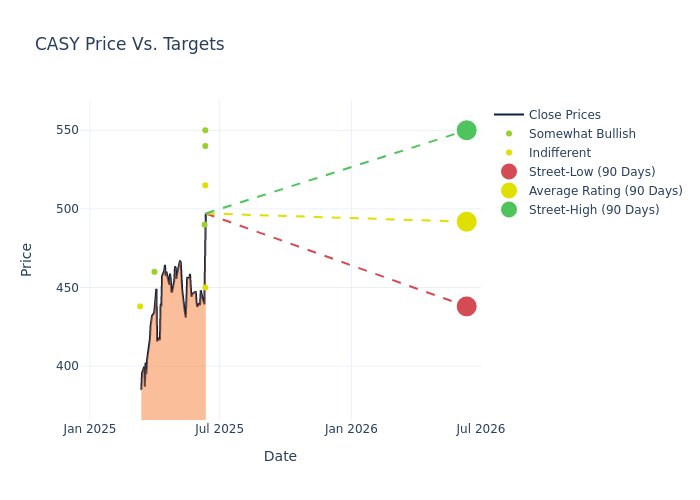Deep Dive Into Casey's General Stores Stock: Analyst Perspectives (7 Ratings)
Providing a diverse range of perspectives from bullish to bearish, 7 analysts have published ratings on Casey's General Stores (NASDAQ:CASY) in the last three months.
The following table encapsulates their recent ratings, offering a glimpse into the evolving sentiments over the past 30 days and comparing them to the preceding months.
| Bullish | Somewhat Bullish | Indifferent | Somewhat Bearish | Bearish | |
|---|---|---|---|---|---|
| Total Ratings | 0 | 5 | 2 | 0 | 0 |
| Last 30D | 0 | 2 | 2 | 0 | 0 |
| 1M Ago | 0 | 1 | 0 | 0 | 0 |
| 2M Ago | 0 | 0 | 0 | 0 | 0 |
| 3M Ago | 0 | 2 | 0 | 0 | 0 |
Insights from analysts' 12-month price targets are revealed, presenting an average target of $500.71, a high estimate of $550.00, and a low estimate of $450.00. This upward trend is apparent, with the current average reflecting a 9.85% increase from the previous average price target of $455.83.

Breaking Down Analyst Ratings: A Detailed Examination
The standing of Casey's General Stores among financial experts is revealed through an in-depth exploration of recent analyst actions. The summary below outlines key analysts, their recent evaluations, and adjustments to ratings and price targets.
| Analyst | Analyst Firm | Action Taken | Rating | Current Price Target | Prior Price Target |
|---|---|---|---|---|---|
| Bonnie Herzog | Goldman Sachs | Raises | Neutral | $450.00 | $385.00 |
| Kelly Bania | BMO Capital | Raises | Market Perform | $515.00 | $450.00 |
| Bradley Thomas | Keybanc | Raises | Overweight | $550.00 | $500.00 |
| Anthony Bonadio | Wells Fargo | Raises | Overweight | $540.00 | $460.00 |
| Pooran Sharma | Stephens & Co. | Maintains | Overweight | $490.00 | $490.00 |
| Bradley Thomas | Keybanc | Announces | Overweight | $500.00 | - |
| Michael Montani | Evercore ISI Group | Raises | Outperform | $460.00 | $450.00 |
Key Insights:
- Action Taken: In response to dynamic market conditions and company performance, analysts update their recommendations. Whether they 'Maintain', 'Raise', or 'Lower' their stance, it signifies their reaction to recent developments related to Casey's General Stores. This insight gives a snapshot of analysts' perspectives on the current state of the company.
- Rating: Delving into assessments, analysts assign qualitative values, from 'Outperform' to 'Underperform'. These ratings communicate expectations for the relative performance of Casey's General Stores compared to the broader market.
- Price Targets: Analysts explore the dynamics of price targets, providing estimates for the future value of Casey's General Stores's stock. This examination reveals shifts in analysts' expectations over time.
To gain a panoramic view of Casey's General Stores's market performance, explore these analyst evaluations alongside essential financial indicators. Stay informed and make judicious decisions using our Ratings Table.
Stay up to date on Casey's General Stores analyst ratings.
About Casey's General Stores
Casey's serves as the nation's third-largest convenience store chain with its 2,900 locations primarily positioned in the Midwest United States. About half of Casey's stores are located in rural towns with populations under 5,000. While fueling stations serve as a key traffic driver, about two thirds of the company's gross profit stems from in-store sales of grocery items, prepared meals, and general merchandise. Casey's owns more than 90% of its stores and operates most of its warehousing and distribution processes internally.
Financial Milestones: Casey's General Stores's Journey
Market Capitalization: Surpassing industry standards, the company's market capitalization asserts its dominance in terms of size, suggesting a robust market position.
Revenue Growth: Casey's General Stores displayed positive results in 3M. As of 30 April, 2025, the company achieved a solid revenue growth rate of approximately 2.28%. This indicates a notable increase in the company's top-line earnings. When compared to others in the Consumer Staples sector, the company faces challenges, achieving a growth rate lower than the average among peers.
Net Margin: Casey's General Stores's net margin surpasses industry standards, highlighting the company's exceptional financial performance. With an impressive 2.46% net margin, the company effectively manages costs and achieves strong profitability.
Return on Equity (ROE): The company's ROE is a standout performer, exceeding industry averages. With an impressive ROE of 2.84%, the company showcases effective utilization of equity capital.
Return on Assets (ROA): Casey's General Stores's ROA excels beyond industry benchmarks, reaching 1.2%. This signifies efficient management of assets and strong financial health.
Debt Management: With a below-average debt-to-equity ratio of 0.84, Casey's General Stores adopts a prudent financial strategy, indicating a balanced approach to debt management.
Analyst Ratings: Simplified
Ratings come from analysts, or specialists within banking and financial systems that report for specific stocks or defined sectors (typically once per quarter for each stock). Analysts usually derive their information from company conference calls and meetings, financial statements, and conversations with important insiders to reach their decisions.
In addition to their assessments, some analysts extend their insights by offering predictions for key metrics such as earnings, revenue, and growth estimates. This supplementary information provides further guidance for traders. It is crucial to recognize that, despite their specialization, analysts are human and can only provide forecasts based on their beliefs.
Breaking: Wall Street's Next Big Mover
Benzinga's #1 analyst just identified a stock poised for explosive growth. This under-the-radar company could surge 200%+ as major market shifts unfold. Click here for urgent details.
This article was generated by Benzinga's automated content engine and reviewed by an editor.